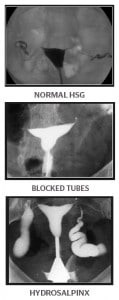Medical contribution by Wende Allen, PA-C

If you’ve begun the process to evaluate the cause of your infertility, no doubt you are concerned about the testing that will be required. In particular, the hysterosalpingogram (HSG) may be the test you are most dreading. Possibly, well-intended friends and family have shared their experiences in crisp detail. You’ve gone to Google for reassurance only to stumble upon blogs from other patients who have not had a good experience and are all too happy to discuss and embellish it. Actually, now you are more anxious than before.
We perform a hysterosalpingogram (HSG) routinely for patients having difficulty conceiving because it is an excellent test used for three primary reasons:
- to see if a patient’s fallopian tubes are open
- to assess whether the uterus has normal shape
- to ensure the cavity is not affected by fibroids, polyps, or scar tissue
The HSG requires the assistance of a certain type of x-ray called a fluoroscopy. At Shady Grove Fertility’s Rockville and Towson offices, we have an x-ray room dedicated to these procedures. An experienced mid-level provider (PA-C or CRNP) or a physician, both of whom are specially trained in advanced gynecological procedures, will perform your procedure. The provider will explain your results immediately following the procedure, and your physician will review these images as part of your medical file.
What exactly happens during an HSG?

The provider will place a speculum into the vagina, in the same manner as if you were having a Pap smear. He or she will cleanse the cervix with an antiseptic solution before placing a small, flexible catheter approximately 1 inch into the cervical canal, where it rests against the cervix. The clinician will pass a small amount of dye through the catheter, filling the uterine cavity and then filling the fallopian tubes. Fluoroscopy is a “live” x-ray that allows us to watch as the dye is traveling through the tubes. The tubes are considered open when spillage of dye occurs at the end of the tubes. This means that the dye has escaped the tube, which tells us that your tube should be able to “pick up” your ovulated egg. Often times, this takes less than 1 minute, with less than 3 teaspoons of dye.
The practitioner gently infuses the dye into the cavity and, although some cramping may occur as the uterine cavity distends with this fluid, it is usually less than menstrual cramping. I’ve found that the patients who comment on intense cramping usually do so because of tubal blockage. If the dye cannot pass through the tube, there is increased pressure at the point of the blockage. By the time a patient expresses discomfort, we’ve recognized the problem, removed the catheter, and there is immediate relief. Again, all of this takes 1 minute or less. And to reduce the cramping, it is our practice at SGF to advise patients to take Ibuprofen or similar over-the-counter nonsteroidal anti-inflammatory drugs (NSAID) 1 hour prior to the procedure.
Is there a risk for complications?
Complications are exceptionally rare. As a precautionary measure, we ask patients who are considered at an increased risk for an infection—those with prior history of pelvic inflammatory disease or known dilated tubes—to start an antibiotic prior to the procedure to reduce this risk. We also instruct patients not to have intercourse or use tampons for 24 hours. Occasionally, patients will experience spotting a few days following and this is completely normal. A potentially serious, but very rare, complication can result if you are allergic to the contrast dye. If you have had any allergic reaction to prior contrast dye (as used with a CT scan, IVP) you need to notify your physician so that he or she can prescribe medications to reduce your risk for a reaction.
When will I get my results?
The practitioner performing your procedure will review your images with you immediately and will provide you with your preliminary results. We will send the images to your electronic medical record so that your physician may review them in a timely manner.
How long will this procedure take?
Most of the waiting occurs prior to the actual procedure when patients are reviewing the consent form and providing us with a urine sample for a pregnancy test. Therefore, we ask that patients arrive 30 minutes prior to their scheduled appointment time. The actual procedure—from prepping the cervix to infusing the contrast—usually takes less than 5 minutes.
Should I not try to get pregnant this month?
We instruct patients to refrain from intercourse for 24 hours to reduce the risk for an infection. However, we do not discourage attempting pregnancy this month.
Will the radiation damage my ovaries and eggs?
At Shady Grove Fertility, we take special care during the HSG to use the lowest radiation dose possible while capturing the best images for evaluation. Radiation exposure from these small doses is not known to injure ovarian tissue and there have been no demonstrated ill effects from this radiation, even if conception occurs in the same month.
If I don’t want an HSG, is there another test to evaluate my tubes?
The alternative to an HSG is called chromotubation, which is a laparoscopic procedure that involves surgery and general anesthesia. During the surgery, the practitioner will infuse the dye into the uterine cavity through a catheter and watch the dye as it travels through your fallopian tubes and spills out into the pelvic cavity, confirming that the tube(s) is open. This procedure involves abdominal incisions and increased discomfort, surgical risks, and costs, and is not usually suggested as a first-line test to evaluate the patency of the tubes. The HSG has the advantage, not only of being a lower risk, lower cost procedure, but will enable your physician to also evaluate the uterine cavity for abnormal shape or filling defects such as myomas, polyps, or adhesions. A laparoscopy cannot evaluate the inside of the uterus.
Patient Testimonials

“I had the HSG procedure done about an hour ago and I must say it wasn’t as bad as I thought. In fact, honestly, it was quite painless for me. It was similar to getting an annual Pap smear, minus the dye being injected. My test was normal and my tubes were open, no blockage. I hadn’t read any blog sites prior to the procedure, and I’m very glad that I didn’t. From reading some of the comments, you would freak yourself out. Every woman’s body is different; therefore our bodies will react differently. I don’t want everyone reading and thinking this test is so HORRIFIC, when it wasn’t. It was really quick.”—Myra
“I had a HSG done yesterday morning in Rockville. I was really worried going into it because of all the negative comments regarding the pain, but am happy to report that it was painless and over pretty quickly. The PA and x-ray tech were really comforting, and informed me of everything they were doing, and it was over before I realized. Thanks to the PA and x-ray tech for making it quick and painless!”—Cynthia
“I just had my HSG performed by Wende Allen (she is wonderful, by the way) 1 hour ago. After reading all the horror stories on the internet, I was so nervous! It was nothing at all. Like a regular OB exam but a little bit longer. My tubes were clear. You might feel something if your tubes are blocked. But please, don’t stress yourself, don’t read all the stories online, and relax. You are in good hands, so you will be fine anyway!!!”—Tanya
“I had this test done early this week, and I had watched and read a lot of stories on how painful this procedure was. Needless to say that I was terrified once I got to the hospital to get the test done. The nurses were really nice and the doctor explained everything. The test was not painful at all. I had worked myself up for nothing. I’m sure everyone is different, but I took three Aleves an hour before the procedure and didn’t feel a thing. I guess I was blessed with a good doctor.”—Ana
“I freaked myself out about the HSG procedure after reading others’ experiences online. I know everyone is different but just wanted to share that my experience was definitely, “Wow, that was not so bad.” It didn’t hurt at all going in and then I felt a little bit of pain on the right side—not so much a sharp pain but more just pressure. It was certainly not unbearable and I just kept thinking about how much I wanted a baby and that once I get pregnant, any discomfort I have to go through will be worth it. I left the office feeling silly for worrying so much about the procedure… So if you have one of these tests scheduled, my advice is to not worry too much about it. It was no big deal for me and hopefully will be the same for you. Best of luck!”—Mallory
So, if the prospect of having a HSG causes your hands to sweat and your heart to palpitate, please recognize that you are not alone. But if your experience is similar to most, you will quickly exclaim, “That wasn’t so bad.” The HSG may sound complicated, but it is actually a very simple and often quick test that provides valuable information in a matter of a few minutes or less. And the best part? It rarely causes the severe discomfort you might expect or have read from Dr. Google.





